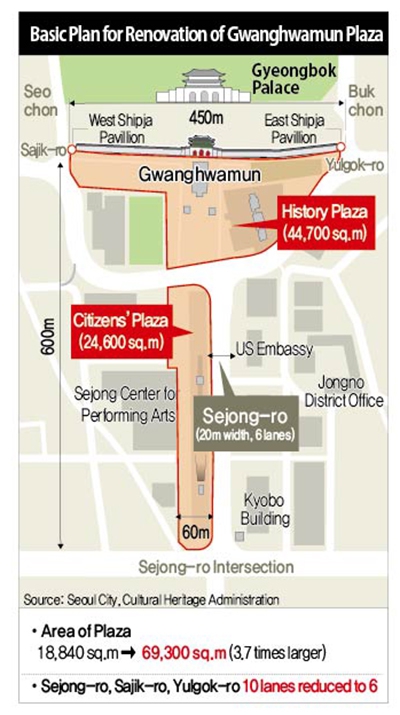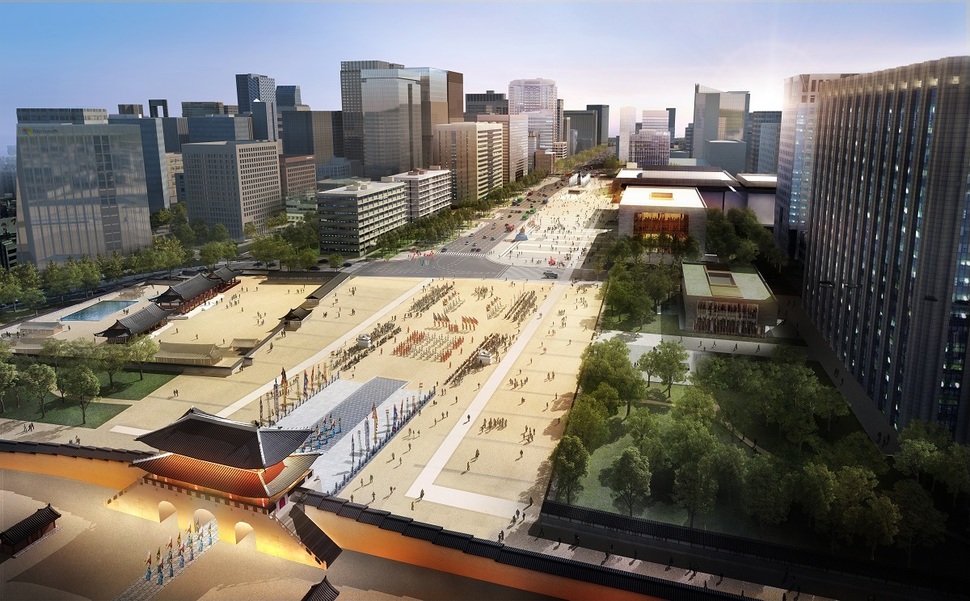A citizens’ plaza and a history plaza will be included in the new construction plan
Instead of the original proposal to eliminate all the roads in the Gwanghwamun area of Seoul and turn the entire area into a pedestrian plaza, the area will be divided into two plazas – a “history plaza” in front of Gwanghwamun Gate and a “citizens’ plaza” in front of the Sejong Center for the Performing Arts.
On the afternoon of Apr. 10, Seoul mayor Park Won-soon and Kim Jong-jin, head of the Cultural Heritage Administration (CHA), signed a work agreement about Seoul’s reorganization of Gwanghwamun Plaza and CHA’s historical restoration of the area in front of Gwanghwamun Gate. The plan is to hold a public discussion and design competition for the project this year, complete the basic and detailed blueprints in 2019, initiate construction in 2020 and wrap up construction in 2021.
Two plazas: one for history and one for citizens
 |
|
Basic Plan for Renovation of Gwanghwamun Plaza
|
The CHA will be creating a historical plaza measuring 450m wide and 100m long with an area of 44,700㎡. To accomplish this, it will expand a street called Saemunan-ro 5-gil and divert Sajik and Yulgok streets onto it. This project will include restoring a stone platform in front of Gwanghwamun Gate, the statues of mythical creatures known as haetae, and the guard towers on the east and west sides of the gate along with their connecting walls.
Because of road construction and damage done to Gyeongbok Palace during the Japanese occupation, the stone platform and the western guard tower were demolished; the haetae statues were relocated; and the eastern guard tower was separated from the wall. Traditional events will be held at the history plaza, including a changing of the guard ceremony.
The city of Seoul will be removing the road passing in front of the Sejong Performing Arts Center and connecting the center to the current Gwanghwamun Plaza as part of constructing a citizens’ plaza measuring 60m wide and 410m long with an area of 24,600㎡. Designed to honor the “candlelight revolution” that citizens led in 2016 and 2017, the plaza will host a variety of cultural events on the stairs leading up to Sejong Center. This is the plan developed in 2005 by Yu Hong-jun, then head of the CHA, and Seung H-sang, an architect.
More practical than the original plan
Though the plan for two plazas at Gwanghwamun is less coherent and spacious than the original plan for a completely pedestrian space, it is thought to be more feasible. The original plaza was fine in and of itself, but it entailed several problems: traffic would have been hard to handle, and the huge underground construction would have carried a massive price tag. As part of the new plan, the ten lanes on Sejong-ro and Sajik-ro and Yulgok-ro streets will be reduced to six lanes.
“It’s better for vehicles, bicycles and pedestrians to mingle above ground than to send all vehicles below ground,” said Kim Eun-hui, head of the Urban Alliance’s policy research center and a member of the Gwanghwamun Forum, which drew up the original plan.
Ham In-seon, an architect with the Gwanghwamun Forum, agreed: “The problem with the original plan was moving the president’s office to Gwanghwamun and the construction cost, which was estimated to be 500 billion won (US$470 million).”
Dispute over the site of the citizens’ plaza
But there are conflicting views about the location and shape of the citizens’ plaza in front of the Sejong Center. “Given the vibrancy of the Jongno area and the route taken by the king of the Joseon Dynasty when he moved from Gwanghwamun Gate toward Jongno, it would be better to attach the plaza to the east side,” said Jeon U-yong, a research professor at the East Asian Culture Research Institute at Hanyang University who participated in the Gwanghwamun Forum.
“Considering the sense of balance of Sejong Street and the connection between the neighborhoods to the east and west, it would have been ideal to leave a road in the middle and build the plaza on both sides,” said Lee Gyeong-hun, an architect and a professor at Kookmin University. The east side of Sejong Street is the location of the National Museum of Korean Contemporary History and the former site of Uijeongbu (which was Council of State during the Joseon Dynasty). Furthermore, the current site of the US Embassy to South Korea, which is also located there, will be returned to South Korean control, which is likely to pave the way for improvement in the future.
In addition, a section of Saemunan-ro 5-gil, the street along which Sajik and Yulgok streets will be rerouted, covers the Samcheong-dong Stream, which is the headwaters of the Cheonggye Stream. This would likely have a negative impact on a mid- to long-term plan to restore the headwaters of the Cheonggye Stream.
Could the Blue House come to Gwanghwamun Plaza?
This plan for Gwanghwamun Plaza was designed for the possibility of the presidential office at the Blue House moving to the main government office in front of Gwanghwamun Gate. But that move is still up in the air because of numerous factors, including security issues and the possible relocation of the capital to Sejong City.
“The original plan at the Gwanghwamun Forum was to make the whole area a plaza by sending the road underground, but many people noted that it wouldn’t make sense to have a massive and time-consuming underground construction project going on in front of Gwanghwamun if President Moon Jae-in moved his office there,” said an architect who participated in the Gwanghwamun Forum.
“During the process of coordinating the plan for Gwanghwamun Plaza, what we mainly discussed with the Blue House was the relocation of the president’s office and what we mainly discussed with the Cultural Heritage Administration was the historical restoration of the area in front of Gwanghwamun Gate,” said Kang Maeng-hun, a “regeneration policy” strategist working for Seoul.
But the Blue House has yet to decide whether it will be moving the president’s office to Gwanghwamun. “We’ve postponed the decision about relocating the office to Gwanghwamun because that’s connected with the relocation of the administrative capital to Sejong City,” said Kim Eui-kyum, spokesperson for the Blue House.
“There are many factors to consider before moving the president’s office to Gwanghwamun, including security,” said a senior government official.
By Kim Kyu-weon and Nam Eun-ju, staff reporters
Please direct questions or comments to [english@hani.co.kr]










